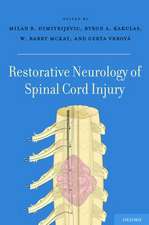Nerve-Muscle Interaction
Autor Gerta Vrbovaen Limba Engleză Paperback – mai 2012
Preț: 385.47 lei
Nou
Puncte Express: 578
Preț estimativ în valută:
73.76€ • 77.02$ • 60.91£
73.76€ • 77.02$ • 60.91£
Carte tipărită la comandă
Livrare economică 15-29 aprilie
Preluare comenzi: 021 569.72.76
Specificații
ISBN-13: 9789401095433
ISBN-10: 9401095434
Pagini: 248
Ilustrații: XIII, 233 p. 37 illus.
Dimensiuni: 155 x 235 x 13 mm
Greutate: 0.35 kg
Ediția:Softcover reprint of the original 1st ed. 1978
Editura: SPRINGER NETHERLANDS
Colecția Springer
Locul publicării:Dordrecht, Netherlands
ISBN-10: 9401095434
Pagini: 248
Ilustrații: XIII, 233 p. 37 illus.
Dimensiuni: 155 x 235 x 13 mm
Greutate: 0.35 kg
Ediția:Softcover reprint of the original 1st ed. 1978
Editura: SPRINGER NETHERLANDS
Colecția Springer
Locul publicării:Dordrecht, Netherlands
Public țintă
ResearchCuprins
1 Early muscle development.- 1.1 Early stages of muscle fibre development.- 1.2 Lack of specialization of myotubes.- 1.3 The dependance of the structural integrity of the developing muscle fibres on innervation.- 2 Development of the motor nerves and their encounter with muscle fibres.- 2.1 Origin of motor nerve fibres and their growth into the periphery.- 2.2 Development of nerves and muscles and their interdependence.- 2.3 Development of stable nerve-muscle connections.- 2.4 Are nerve-muscle connections specified?.- 2.5 Conclusions.- 3 Development of the neuromuscular junction.- 3.1 Distribution of ACh receptors during early development.- 3.2 Stabilization of chemosensitivity at the neuromuscular junction.- 3.3 Development of the subneural apparatus.- 3.4 Formation of stable nerve-muscle connections.- 3.5 Changes of chemosensitivity outside the endplate.- 3.6 Maintenance of endplate chemosensitivity.- 3.7 Pattern of innervation of muscle fibres.- 3.8 Conclusions.- 4 Differentiation of skeletal muscle fibres.- 4.1 The muscles of lower vertebrates and birds.- 4.2 Mammalian muscles.- 4.3 How is differentiation into different fibre types induced?.- 4.4 Conclusions.- 5 The effects of denervation on muscle fibre properties and the regulation of chemosensitivity.- 5.1 Morphological changes following denervation.- 5.2 Metabolic changes in denervated muscles.- 5.3 Changes in contractile properties of denervated muscle.- 5.4 Changes in electrical properties of the membrane on denervation.- 5.5 Changes of chemosensitivity at the endplate.- 5.6 Conclusions.- 6 Re-innervation of the muscle by its motor nerve.- 6.1 Nerve growth.- 6.2 Establishment of nerve-muscle connections by the regenerating nerve fibre.- 6.3 Maturation of the regenerated axon and recovery of the muscle.- 6.4 Effects of muscle on normal and regenerating motor nerve terminals.- 6.5 Conclusion.- 7 The mammalian motor unit.- 7.1 Specialization of motoneurones.- 7.2 Matching properties of different motoneurones to the muscle fibres they supply.- 7.3 Specialization of the vascular bed of slow and fast mammalian muscles.- 7.4 How is the matching of muscle fibres to their motoneurones brought about?.- 7.5 Development of the motor unit.- 7.6 Conclusions.- 8 Plasticity in the neuromuscular system.- 8.1 Can different skeletal muscle fibres be transformed from one type to another?.- 8.2 Can the characteristic properties of neurones and their terminals be altered?.- 8.3 Specificity of nerve-muscle connections.- 8.4 Conclusions.- 9 Some examples of disturbances of nerve-muscle interactions.- 9.1 Disturbances caused by a change in the function of the motoneurone.- 9.2 Consequences of disease of the motoneurone, or axon.- 9.3 Disturbance due to disease of the neuromuscular junction.- 9.4 Disease of the muscle.- 9.5 Retrograde influences on the motoneurone.- References.



